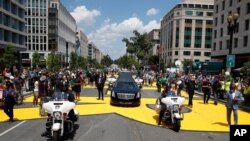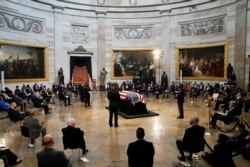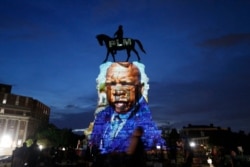The body of the late U.S. congressman and civil rights icon John Lewis returned to Washington on Monday, where it will lie in state as lawmakers and the public pay their last respects to Lewis' life-long efforts to promote civil rights.
Lewis died last week at the age of 80 after a yearlong battle with advanced-stage pancreatic cancer.
His flag-draped casket was escorted Monday to the Capitol, where he served the people of his Georgia district for 33 years. Before arriving on Capitol Hill, the motorcade carrying his body took a final journey past several civil rights landmarks in Washington as well as a new mural on a street near the White House reading "Black Lives Matter."
In remarks in the Capitol Rotunda, House of Representatives Speaker Nancy Pelosi called Lewis the conscience of the Congress.
"It is fitting that John Lewis joins this pantheon of patriots, resting upon the same catafalque as President Abraham Lincoln," she said. A catafalque is an ornamental wooden framework that supports a coffin lying in state.
Pelosi had led a delegation Monday to Joint Base Andrews in Maryland to greet Lewis' casket.
Senate Majority Leader Mitch McConnell also praised Lewis, saying, "Lewis lived and worked with urgency because the task was urgent."
Due to concerns over the coronavirus, the public viewing is taking place just outside the Capitol on the building's east side. Visitors are required to wear masks and engage in social distancing.
Democratic presidential candidate and former Vice President Joe Biden paid his respects Monday. Biden and Lewis became friends during the two decades they served together in Congress.
Vice President Mike Pence and his wife, Karen, also paid their respects Monday evening.
Absent from the ceremonies was President Donald Trump, who has publicly traded words with Lewis on Twitter. After Lewis said the president was not legitimate, Trump called Lewis' congressional district "crime-infested."
Before arriving at the Capitol, the motorcade carrying Lewis' body took a circuitous route through the city, with a slow pass by the Lincoln Memorial where, in 1963, Lewis had been the youngest speaker during the Martin Luther King Jr.-led March on Washington. The motorcade then drove by the memorial honoring King, on the tidal basin just off the National Mall.
Next, the motorcade wound across the Mall, past the White House and onto Black Lives Matter Plaza, created after the death of George Floyd, a Black man, while he was in police custody. It was where the civil rights icon made his last public appearance in early June. Lewis, who was diagnosed in late December with pancreatic cancer, died July 17.
From there, the motorcade worked its way back to the Mall for a pass by the African American Museum, where Lewis is remembered among other civil rights activists.
Lewis is the second Black lawmaker to lie in state in the U.S. Capitol. Congressman Elijah Cummings, who died last year, was the first.
The public will be able to pay their respects to Lewis all day Tuesday, before his body is flown to Atlanta to lie in state Wednesday in the Georgia Capitol. A funeral will be held at Ebenezer Baptist Church, the historically Black church where the Rev. Martin Luther King Jr. preached. He will be laid to rest in Atlanta's South View Cemetery.
Prior to returning to Washington, Lewis lay in state Sunday in Montgomery, Alabama, to give the people of his home state a final chance to pay their last respects.
Lewis' body arrived at the Alabama Capitol shortly after a horse-drawn caisson brought his flag-draped casket across the Edmund Pettus Bridge in Selma, the same bridge where police beat him and other civil rights marchers when they tried to cross it during a walk to Montgomery on March 7, 1965. That day became known as "Bloody Sunday."
That day was known as "Bloody Sunday." No one at the bridge 55 years ago would imagine that one day, a Black man would cross that same bridge in honor, with flags across the state flown at half-staff as a sign of respect for him and all he fought to achieve.
Sunday was the second day of nearly a week of memorials and remembrances for Lewis.
Lewis rose to fame as a leader of the modern-day American civil rights movement of the 1960s. At 23, he worked closely with King and was the last surviving speaker from the August 1963 March on Washington where King gave his famous "I Have a Dream" speech.
The civil rights movement led Lewis into a career in politics. He was elected to the Atlanta City Council in 1981 and to Congress in 1986, calling the latter victory "the honor of a lifetime." He served 17 terms in the U.S. House of Representatives from Georgia's fifth district.














